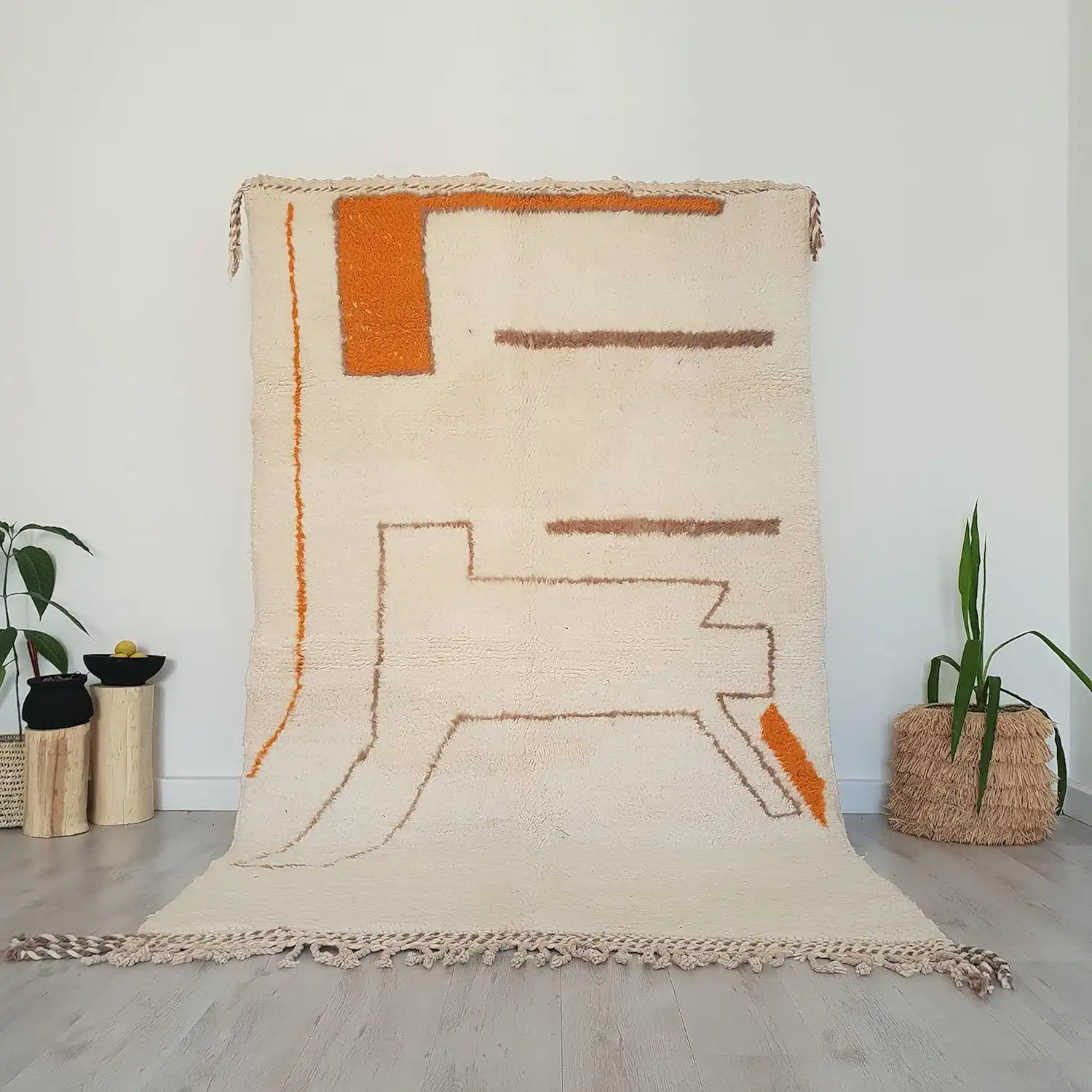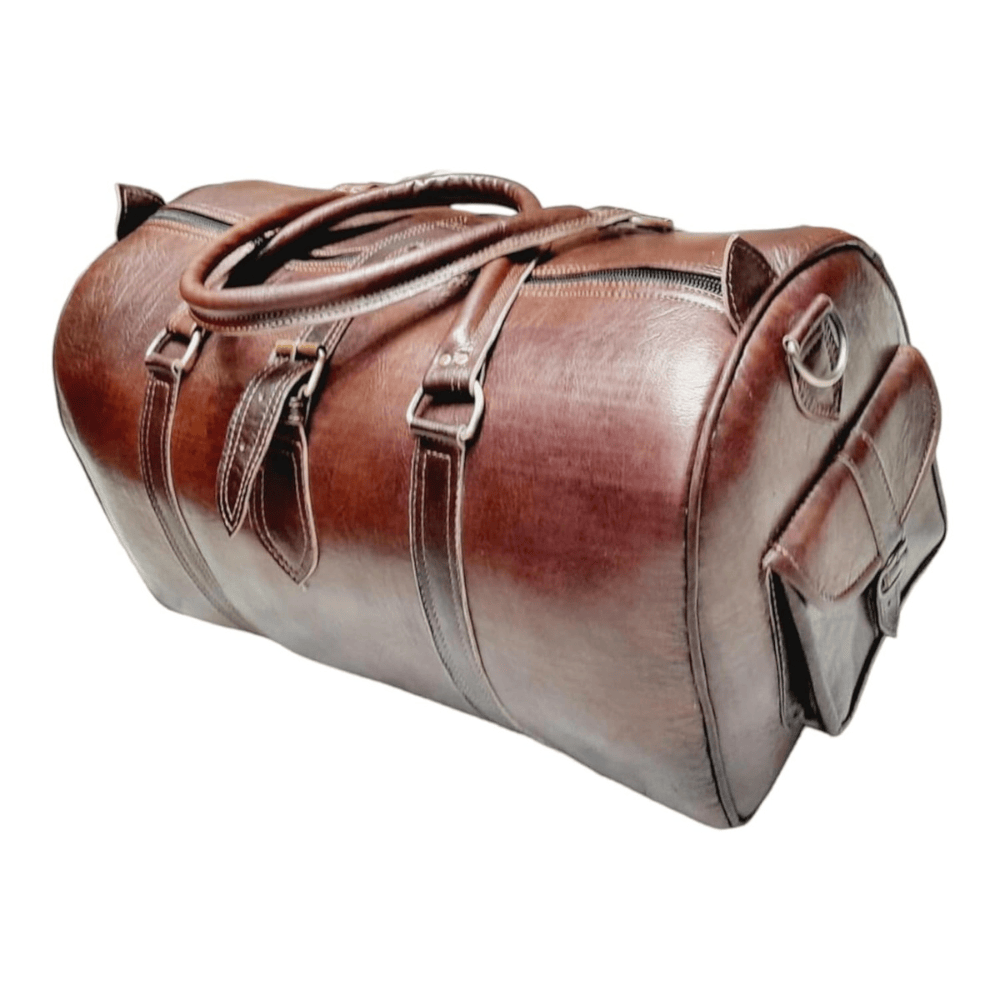Embark on a journey of creativity and tradition as we delve into the intricate process of weaving a Moroccan rug from wool. Steeped in centuries-old craftsmanship, this art form embodies the rich cultural heritage of Morocco. Join us as we explore the steps involved in creating these exquisite pieces of functional art, from selecting the finest wool to mastering the weaving techniques passed down through generations. Get ready to be inspired and empowered to unleash your creativity!
The Traditional Weaving Techniques of Moroccan Rugs

Moroccan rugs, also known as Berber rugs, are traditionally woven by skilled artisans using age-old techniques that have been passed down through generations. These rugs are renowned for their intricate designs, vibrant colors, and durable construction. Here’s a detailed overview of the traditional weaving process:
Materials Gathering: The process begins with gathering the necessary materials. Traditionally, Moroccan rugs are woven using wool sourced from local sheep. The wool is sheared, cleaned, and carded to prepare it for spinning. In some cases, natural dyes sourced from plants, minerals, or insects are used to color the wool.
Spinning: Once the wool is prepared, it is spun into yarn using either a drop spindle or a spinning wheel. This step is crucial as it determines the thickness and strength of the yarn. Skilled artisans can create different yarn thicknesses for various parts of the rug, depending on the design requirements.
Dyeing: If natural dyes are being used, the yarn is dyed in large pots or vats using techniques that have been refined over centuries. Each color is derived from specific natural sources, resulting in a rich and harmonious color palette. The dyed yarn is then left to dry under the sun.
Designing: Before the weaving process begins, the rug’s design is planned out. Traditional Moroccan rugs feature geometric patterns, symbols, and motifs that hold cultural significance. These designs are often passed down through oral tradition and can vary depending on the region and tribe.
Setting Up the Loom: The loom is the frame used to hold the vertical threads (warp) in place while the horizontal threads (weft) are woven through them. In traditional Moroccan weaving, a vertical loom is commonly used. The warp threads are stretched tightly and evenly across the loom, creating a foundation for the rug.
Weaving: With the loom set up, the weaving process begins. Skilled artisans use a variety of techniques, including knotting, flatweave, or pile weave, to create the intricate patterns and textures found in Moroccan rugs. The weft threads are woven over and under the warp threads to create the desired design.
Finishing Touches: Once the weaving is complete, the rug undergoes several finishing processes. This may include trimming any excess yarn, securing the edges with binding or braiding, and washing the rug to remove any remaining dirt or dye residues. Finally, the rug is left to dry in the sun.
Final Inspection: Before being sold or used, the rug undergoes a final inspection to ensure quality and craftsmanship. Any imperfections are corrected, and the rug is carefully rolled and packaged for transportation.
Overall, the traditional weaving of Moroccan rugs is a labor-intensive process that requires skill, patience, and an understanding of cultural heritage. These rugs are not just functional floor coverings but also works of art that reflect the rich history and craftsmanship of the Berber people.
Exploring the Materials in Moroccan Rug Weaving
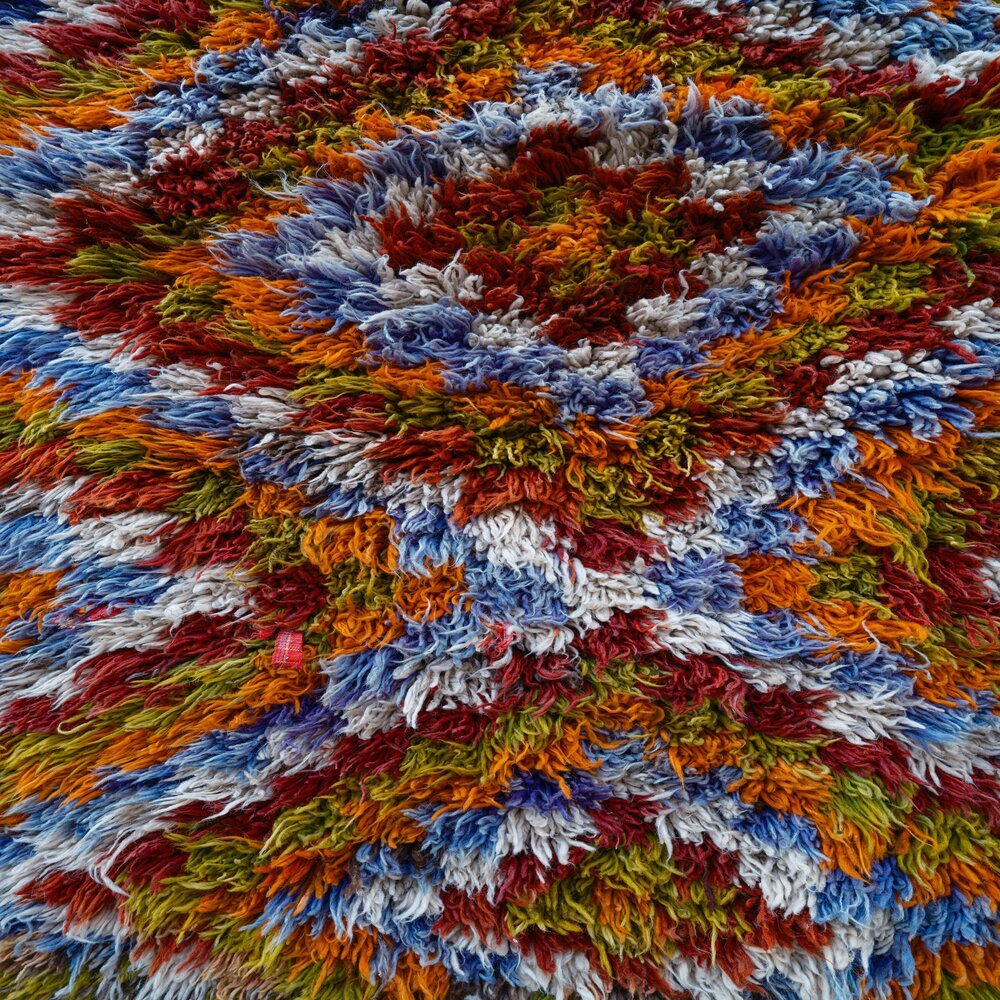
Moroccan rugs woven using a variety of materials sourced from nature, reflecting the rich cultural and environmental heritage of the region. Here’s a detailed look at the materials commonly used in the weaving of Moroccan rugs:
Wool: Wool is the primary material used in the weaving of Moroccan rugs. It is sourced from local sheep, which are raised by nomadic or semi-nomadic tribes in the Atlas Mountains and other regions of Morocco. Wool is favored for its durability, softness, and ability to absorb dyes, making it ideal for creating intricate designs and vibrant colors in the rugs. The wool used in Moroccan rugs is typically hand-sheared, cleaned, carded, and spun into yarn by skilled artisans.
Natural Dyes: Traditionally, Moroccan rugs are dyed using natural dyes derived from plants, minerals, and insects. These dyes are environmentally friendly and produce rich, earthy colors that are characteristic of Moroccan rug designs. Common sources of natural dyes include indigo, madder root, henna, pomegranate peel, saffron, and various types of tree bark. Artisans employ techniques passed down through generations to extract, mix, and apply these dyes to the wool yarn, resulting in a diverse and harmonious color palette.
Cotton: While wool is the primary fiber used in Moroccan rugs, cotton is sometimes incorporated into the design, particularly for the foundation or warp threads. Cotton is valued for its strength and stability, which helps to provide structure and support to the rug. Cotton yarn may be used sparingly in areas where additional reinforcement is needed, such as along the edges or in the foundation of the rug.
Synthetic Materials (Modern Influence): In more recent times, synthetic materials such as nylon or polyester have been introduced into the weaving of Moroccan rugs. While these materials may offer certain advantages such as increased durability or cost-effectiveness, they are not traditionally used in authentic Berber rugs. However, their incorporation into modern rug production has influenced some contemporary interpretations of Moroccan rug designs.
Metallic Threads (Decorative): In some Moroccan rugs, particularly those made for ceremonial or decorative purposes, metallic threads may be incorporated into the design. These threads, often made of silver or gold, add a touch of luxury and shimmer to the rug, enhancing its visual appeal and cultural significance.
The materials used in the weaving of Moroccan rugs reflect a deep connection to the natural world and a commitment to traditional craftsmanship. From locally sourced wool to natural dyes extracted from plants, every aspect of the material selection process contributes to the unique beauty and cultural significance of these timeless textiles.
Exploring the Unique Qualities of Moroccan Rugs

Moroccan Carpet are revered worldwide for their unique qualities, which stem from a combination of cultural heritage, craftsmanship, and artistic expression. Here’s a comprehensive overview of what makes Moroccan rugs truly unique:
Cultural Heritage: Moroccan rugs are deeply rooted in the cultural heritage of the Berber people, who are indigenous to North Africa. The art of rug weaving has been passed down through generations, with techniques, designs, and motifs often reflecting the customs, beliefs, and traditions of Berber tribes. Each rug tells a story, preserving elements of Berber history and identity.
Distinctive Designs: One of the most striking features of Moroccan rugs is their distinctive designs, characterized by geometric patterns, symbols, and motifs. These designs often hold symbolic meanings related to protection, fertility, spirituality, and other aspects of Berber life. Common motifs include diamonds, triangles, chevrons, and zigzags, each with its own significance and interpretation.
Vibrant Colors: Moroccan rugs are renowned for their vibrant and rich color palettes, which are achieved through the use of natural dyes derived from plants, minerals, and insects. These dyes produce earthy tones such as reds, blues, greens, yellows, and browns, imbuing the rugs with warmth, depth, and character. The colors may vary depending on the region, local resources, and artisan preferences.
Handcrafted Artistry: Moroccan rugs are meticulously handcrafted by skilled artisans using traditional weaving techniques that have been refined over centuries. From shearing the sheep and spinning the wool to knotting the yarn and finishing the edges, every step of the process is carried out with care and precision. This handcrafted approach ensures each rug is unique and imbued with the personality of its maker.
Textural Variations: Moroccan rugs exhibit a wide range of textures, achieved through different weaving techniques such as pile weave, flatweave, and knotting. Pile weave rugs, characterized by their raised surface, offer plushness and warmth, while flatweave rugs are more lightweight and reversible. These textural variations add depth and interest to the rugs, inviting tactile exploration.
Versatility and Utility: Beyond their aesthetic appeal, Moroccan rugs are prized for their versatility and utility. They serve as functional floor coverings, providing warmth and insulation in the cold desert nights of the Atlas Mountains. Additionally, they are used as seating, bedding, and ceremonial items in Berber households, reflecting their integral role in daily life and cultural rituals.
Global Appeal: In recent years, Moroccan rugs have gained popularity beyond North Africa, capturing the attention of interior designers, collectors, and enthusiasts worldwide. Their timeless beauty, cultural significance, and artisanal craftsmanship have made them sought-after decor items for both traditional and contemporary spaces. As a result, Moroccan rugs have become iconic symbols of global style and sophistication.
What makes Moroccan rugs unique is not just their aesthetic appeal, but also their deep cultural significance, artisanal craftsmanship, and timeless beauty. They represent a living tradition that continues to thrive and evolve, connecting people across continents through the shared appreciation of art and heritage.
The Weaving Duration of Moroccan Rugs

The time it takes to weave a Moroccan rug can vary significantly depending on various factors such as the size of the rug, complexity of the design, weaving technique, and the skill level of the artisan. Here’s a detailed breakdown of the factors influencing the time it takes to weave a Moroccan rug:
Size of the Rug: One of the primary factors influencing the weaving time is the size of the rug. Larger rugs naturally require more time to weave than smaller ones. A small rug, such as a doormat or accent rug, may take a few weeks to complete, while a large area rug could take several months or even years to weave.
Complexity of the Design: The complexity of the rug’s design also plays a significant role in determining the weaving time. Intricate patterns, detailed motifs, and precise color transitions require more time and skill to execute. Artisans may need to carefully plan and chart out the design before beginning the weaving process, which can add to the overall time investment.
Weaving Technique: Moroccan rugs can be woven using various techniques, including pile weave, flatweave, and knotting. Each technique has its own intricacies and challenges, which can affect the speed of weaving. For example, pile weave rugs, which have a raised surface, typically take longer to weave than flatweave rugs due to the additional knotting and trimming involved.
Skill Level of the Artisan: The skill and experience of the artisan weaving the rug also influence the time it takes to complete. Experienced weavers who have mastered their craft may work more efficiently and produce higher-quality rugs in less time compared to novice artisans. However, even skilled artisans may spend weeks or months weaving a single rug, especially if it is large or complex.
Additional Processes: In addition to the actual weaving, there are several additional processes involved in creating a Moroccan rug that can contribute to the overall time required. These processes may include preparing the wool, spinning the yarn, dyeing the colors, setting up the loom, finishing the edges, and washing and drying the finished rug. Each of these steps requires time and attention to detail, adding to the overall production timeline.
The time it takes to weave a Moroccan rug can range from a few weeks to several months or even years, depending on the aforementioned factors. Regardless of the time investment, the end result is a unique and meticulously crafted piece of art that reflects the skill, creativity, and cultural heritage of the artisans who create it.
Evaluating the Investment Potential of Moroccan Rugs

Determining whether Moroccan rugs are worth the investment involves considering various factors, including their quality, craftsmanship, cultural significance, and potential resale value. Here’s a detailed exploration of why Moroccan rugs are often considered valuable investments:
Craftsmanship and Quality: Moroccan rugs are renowned for their exceptional craftsmanship and high-quality materials. They are handwoven by skilled artisans using traditional techniques that have been passed down through generations. The use of natural wool and dyes, along with meticulous attention to detail, results in durable and long-lasting rugs that can withstand years of use.
Unique Designs and Cultural Significance: Moroccan rugs are prized for their unique designs, which often feature geometric patterns, symbols, and motifs that hold cultural significance. Each rug tells a story and reflects the heritage and identity of the Berber people. As such, owning a Moroccan rug can be a way to connect with and appreciate a rich cultural tradition.
Artisanal Value and Ethical Considerations: Investing in a Moroccan rug supports local artisans and communities, many of whom rely on rug weaving as a source of income. By purchasing directly from artisans or reputable cooperatives, buyers can ensure fair wages and working conditions for the craftsmen and women involved in the production process.
Decorative and Functional Versatility: Moroccan rugs are versatile decor items that can enhance the aesthetic appeal of any space, whether traditional or contemporary. Their vibrant colors, intricate patterns, and textural variations make them suitable for use as floor coverings, wall hangings, or even as decorative throws. They can add warmth, character, and a touch of exoticism to interiors, making them highly sought after by interior designers and collectors.
Potential for Appreciation in Value: High-quality, vintage Moroccan rugs have demonstrated a track record of appreciating in value over time. As awareness of Moroccan rugs grows and demand increases, particularly in global markets, well-preserved and rare pieces can become valuable collectibles. Vintage rugs with unique designs or historical significance may command premium prices at auctions or in specialty markets.
Investment in Cultural Heritage: Beyond their monetary value, investing in Moroccan rugs is an investment in cultural heritage and preservation. By supporting traditional craft practices and sustainable production methods, buyers contribute to the continued survival and vitality of Berber rug weaving traditions.
Considerations for Authenticity and Condition: When considering the investment value of a Moroccan rug, it’s important to verify its authenticity and assess its condition. Authenticity can be confirmed through factors such as the rug’s origin, materials, and weaving techniques. Additionally, the rug’s condition, including its age, wear, and any repairs or restorations, can impact its value and investment potential.
Moroccan rugs are often considered worth the investment due to their exceptional craftsmanship, unique designs, cultural significance, and potential for appreciation in value. However, buyers should conduct thorough research, purchase from reputable sources, and carefully consider factors such as authenticity, quality, and condition before making an investment decision.


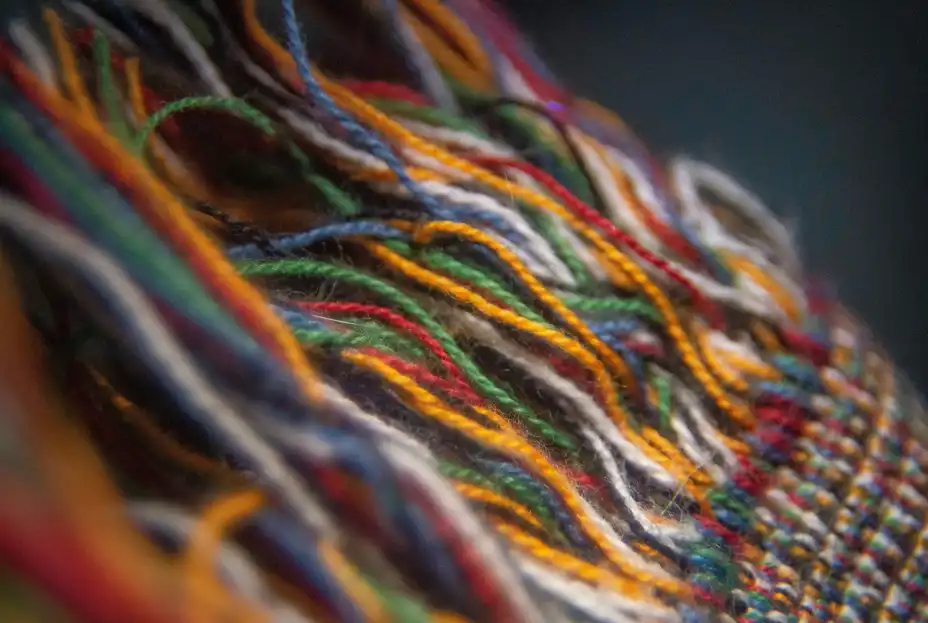
Features
Traditional Hand Weaving
A time-honored craft, traditional hand weaving includes interlacing threads or yarns by hand on a loom to create textiles. Craftspeople all throughout the world continue to use this antiquated technique of producing textiles, which predates contemporary industrial procedures and preserves cultural traditions and legacy.
Premium Wool Material
Superior softness, durability, adaptability, and performance make premium wool fiber a highly sought-after textile. Selected sheep breeds are the source of premium wool, which is meticulously prepared to maintain its inherent characteristics and finds extensive use in upscale clothing and opulent home furnishings. It is a timeless option for discriminating customers looking for quality and craftsmanship in their textile items because of its sustainability, comfort, and opulent feel.
Intricate Geometric Designs
A common feature of many artistic traditions worldwide are intricate geometric motifs, which are a reflection of people’s interest with symmetry, patterns, and order. Geometric shapes like lines, circles, triangles, squares, and polygons are commonly organized in complex ways to produce visually arresting and harmonious compositions. These patterns are what define these designs.
Vibrant Color Palette
In a vibrant color palette, you’ll often find a wide range of hues spanning across the color spectrum. Reds, oranges, yellows, greens, blues, and purples are common components, but they are not limited to these traditional colors. Neon tones, electric shades, and rich, deep hues are also frequently included to enhance the vibrancy of the palette.
Versatile Size Options
The availability of a broad range of measurements or scales for a specific rugs, object, or design feature is referred to as versatile size possibilities. This versatility to different situations and applications satisfies a range of demands and preferences. Providing a range of size alternatives is essential in many businesses to satisfy diverse consumer needs, accommodate varying spatial restrictions, and guarantee usability on several platforms or devices. The accessibility and usefulness of a Moroccan Carpet are improved when it is available in multiple sizes.
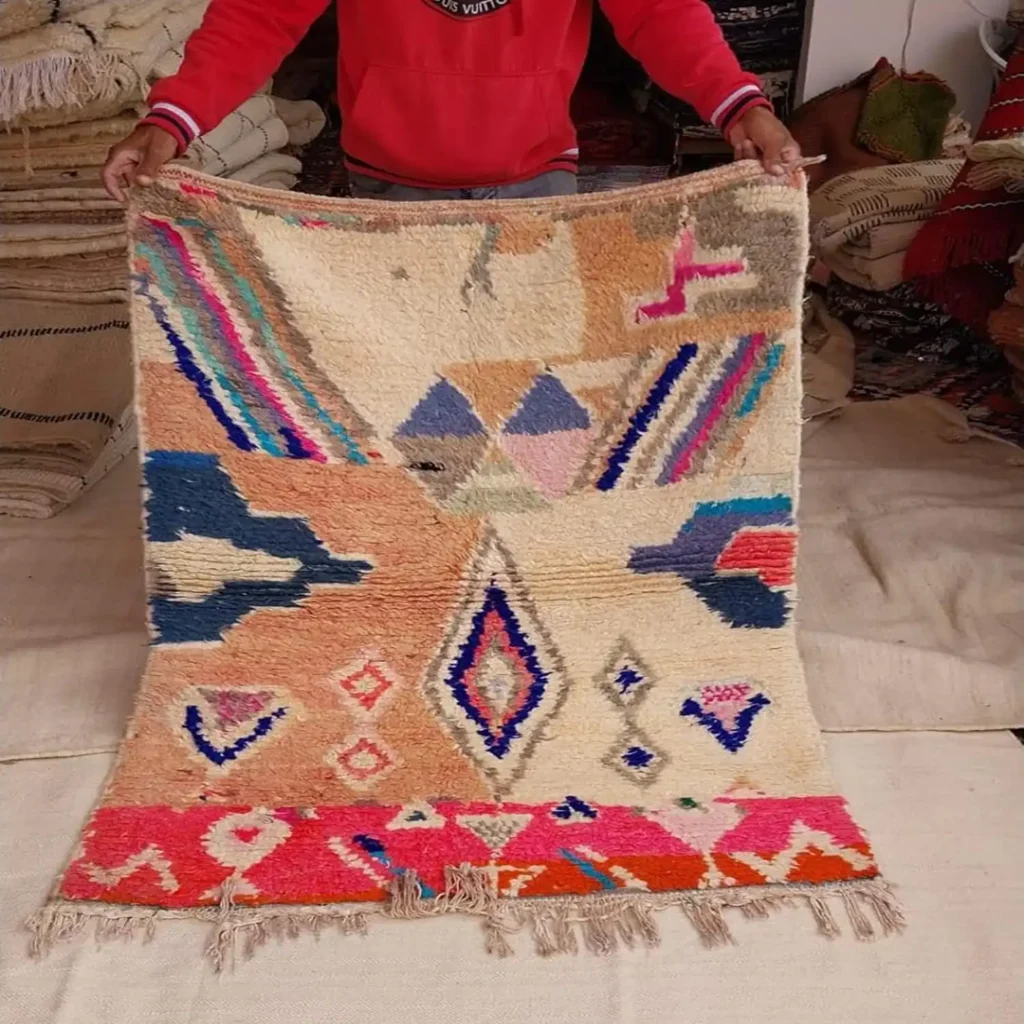

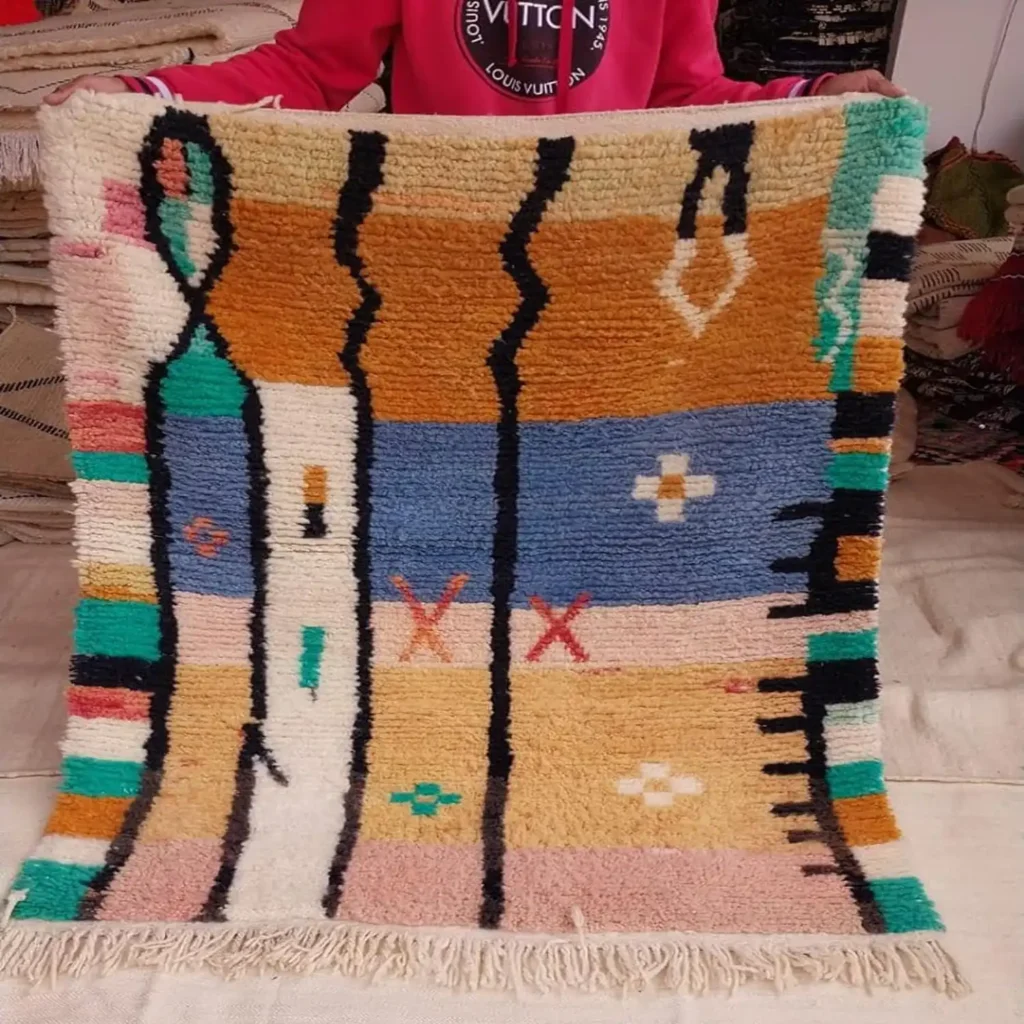
Cultural Heritage
Each Moroccan rug tells a story of tradition, craftsmanship, and cultural heritage, making it a meaningful addition to any home.
Artisanal Craftsmanship
Every rug is a labor of love, with artisans pouring their skill, creativity, and passion into each intricately woven piece.
Timeless Appeal
With their timeless designs and enduring quality, Moroccan rugs never go out of style, adding beauty and charm to any interior space.
Functional and Decorative
Moroccan rugs not only enhance the aesthetic appeal of a room but also provide warmth, comfort, and insulation.
Investment-Worthy
Considered collector’s items and heirlooms, Moroccan rugs are a valuable investment that appreciates in both beauty and value over time.
Moroccan Handwoven Wool Rugs
Traditional Moroccan Kilim Rug, Cotton, Vintage

Introduce a touch of vintage charm to your home with our exquisite Traditional Moroccan Kilim Rug. Handcrafted from high-quality cotton, this rug features a timeless kilim design that pays homage to the rich cultural heritage of Morocco. The intricate patterns and vibrant colors evoke the warmth and vibrancy of Moroccan markets, while the vintage finish adds character and authenticity to any space. Whether placed in your living room, bedroom, or dining area, this rug is sure to become a statement piece that enhances the ambiance of your home. With its durable construction and unique craftsmanship, our Traditional Moroccan Kilim Rug is a timeless treasure that will be cherished for years to come.
6×10 Moroccan Rug, Berber Carpet, Flat Handwoven Wool

The 6×10 Moroccan rug or Berber carpet, meticulously handwoven from wool in a flat style, epitomizes the rich cultural tapestry, artisanal mastery, and timeless allure of traditional Moroccan textiles. Woven by skilled artisans hailing from the indigenous Berber tribes of North Africa, this rug is more than a mere floor covering; it’s a cherished embodiment of centuries-old craftsmanship and heritage. Measuring 6 feet by 10 feet, its dimensions offer versatility, ideal for adorning a range of living spaces with its captivating presence. Crafted from locally sourced wool, prized for its softness, durability, and sustainable qualities, this rug ensures both aesthetic beauty and practical functionality. Expect to encounter a symphony of geometric patterns, intricate motifs, and symbolic designs that narrate tales of Berber culture and tradition, each thread a testament to the artisan’s skill and the rug’s enduring legacy.
2×3 Handcrafted Moroccan Wool Accent Rug – Light/Dark Gold

The 2×3 handcrafted Moroccan wool accent rug in light and dark gold hues is a stunning testament to the exquisite artistry and cultural heritage of Moroccan weaving traditions. Created with meticulous attention to detail by skilled artisans, this rug epitomizes the time-honored craftsmanship. Measuring 2 feet by 3 feet, it serves as a versatile accent piece, perfect for adding a touch of Moroccan elegance to any space, whether it’s a cozy reading nook, an entryway, or a bathroom. Crafted from high-quality wool sourced from local sheep, this rug promises plush softness underfoot, resilience to wear, and exceptional longevity. Its intricate design features a harmonious blend of light and dark gold tones, evoking the warmth of the Moroccan sun and the richness of desert landscapes. Each woven motif and pattern carries deep cultural significance, reflecting the traditions, beliefs, and stories passed down through generations of Berber artisans. Whether used as a decorative element or a functional accent, this handcrafted Moroccan wool rug exudes timeless charm and sophistication, transforming any space into a haven of beauty and cultural richness.
Contemporary Moroccan Hand-Knotted Wool Rug in Beige

The contemporary Moroccan hand-knotted wool rug in beige exemplifies the fusion of traditional craftsmanship with modern design sensibilities, offering a captivating blend of heritage and innovation. Hand-knotted by skilled artisans using age-old techniques passed down through generations, this rug embodies the rich cultural heritage of Morocco while embracing a contemporary aesthetic. Its neutral beige tone, a hallmark of Moroccan design, exudes a sense of warmth, tranquility, and versatility, making it a perfect addition to a wide range of interior settings. Crafted from luxurious wool fibers, sourced locally for their quality and sustainability, this rug promises both exquisite softness underfoot and exceptional durability. The intricate knotting technique employed in its creation ensures a high level of detail and texture, adding depth and visual interest to any room. Whether used as a focal point in a modern living room or as a subtle accent in a minimalist bedroom, this contemporary Moroccan rug effortlessly combines timeless elegance with contemporary flair, elevating any space with its understated sophistication and cultural resonance.
Conclusion
Unlock the secrets of Moroccan rug weaving and unleash your creativity with the comprehensive guide. From the traditional hand-weaving process to the timeless beauty of these artisanal creations, discover why Moroccan rugs are more than just floor coverings—they’re works of art that add warmth, style, and cultural richness to any home.



